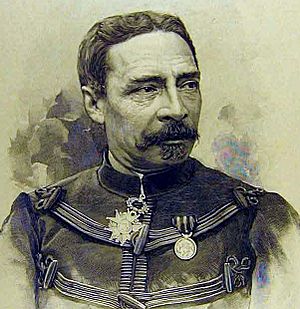Alfred-Amédée Dodds facts for kids
Quick facts for kids
Alfred Dodds
|
|
|---|---|

Dodds on the cover of L'Illustration in 1893
|
|
| Birth name | Alfred Amédée Dodds |
| Born | 6 February 1842 Saint-Louis, Senegal |
| Died | 17 July 1922 (aged 80) Paris, France |
| Buried |
Père Lachaise Cemetery
|
| Branch |
|
| Service years | 1862–1907 |
| Rank | Général de division |
| Wars |
|
Alfred Amédée Dodds (born February 6, 1842 – died July 17, 1922) was an important French military leader. He commanded French troops in different parts of the world. For example, he led forces in Senegal starting in 1890. He also commanded French troops during the second mission to stop the Boxer Rebellion and during the Second Franco-Dahomean War.
Alfred Dodds was known for his mixed heritage. He had both European and African roots. Because of this, he became a famous example of African leadership in the early 1900s.
From 1892 to 1894, he led the French takeover of Dahomey. This was one of the strongest kingdoms in West Africa before colonial times. Dodds fought against King Béhanzin of Dahomey. A powerful French politician, Georges Clemenceau, personally helped Dodds get the job as expedition leader.
Biography
Early Life
Alfred Dodds was born on February 6, 1842. His birthplace was Saint-Louis, in Senegal. His father, Antoine Henri Dodds, was a merchant and post office director. He had mixed European and African heritage. Alfred's mother, Charlotte de la Chapelle, was a signare. This term was used for women of mixed French and African descent in Senegal. Alfred was the oldest of ten children in his family.
His grandfather on his father's side was John Dodds. He was a British Army officer. He also served as a special assistant to the last English governor of Saint-Louis. John Dodds married a Senegalese woman who also had French and African roots.
Military Career
Alfred Dodds finished his studies at the École spéciale militaire de Saint-Cyr in 1862. This was a famous French military school. In 1867, he became a lieutenant in the Troupes de marine. These were special troops for overseas colonies. He was sent to the French colony of Réunion. There, he showed great bravery during riots in 1868.
He was promoted to captain in December 1869. During the Franco-Prussian War in 1870, he proved his military skill. He was part of the Blue Division and was made a Knight of the Legion of Honour. This is a very high award in France. After the Battle of Sedan, he was captured. But he managed to escape. He then joined other French armies, the Armée de la Loire and later the Armée de l'Est. At the end of the war, he was held in Switzerland.

After the war, he served in Senegal from 1871 to 1878. Then he went to Cochinchina (part of modern-day Vietnam) from 1878 to 1879. In 1879, he became a battalion leader. He served again in Senegal and fought in Casamance from 1879 to 1883. Later, he became a lieutenant colonel. He then took part in the war to conquer Tonkin, also in Southeast Asia.
By 1887, he was a colonel. He helped fight against rebellions in the Fouta Djalon region of French Guinea. In 1891, he received another high honor, Commander of the Legion of Honour. He was then given command of the Eighth Colonial Army in Toulon, France. In 1892, he was put in charge of the forces in Dahomey. He led the Second Franco-Dahomean War there.
Dodds was made a général de brigade (Brigadier General) in 1892. He also became an inspector of naval infantry. He received the Grand Officer of the Legion of Honour. In 1898, he was promoted to General of Division. In 1900, he was given the important role of High Commander of colonial troops in French Indochina.
From 1903 to 1907, he was the high commander of naval infantry. He was also a member of the High Council of War. In 1907, he received the highest French honors: the Grand Cross of the Legion of Honour and the Military Medallion.

